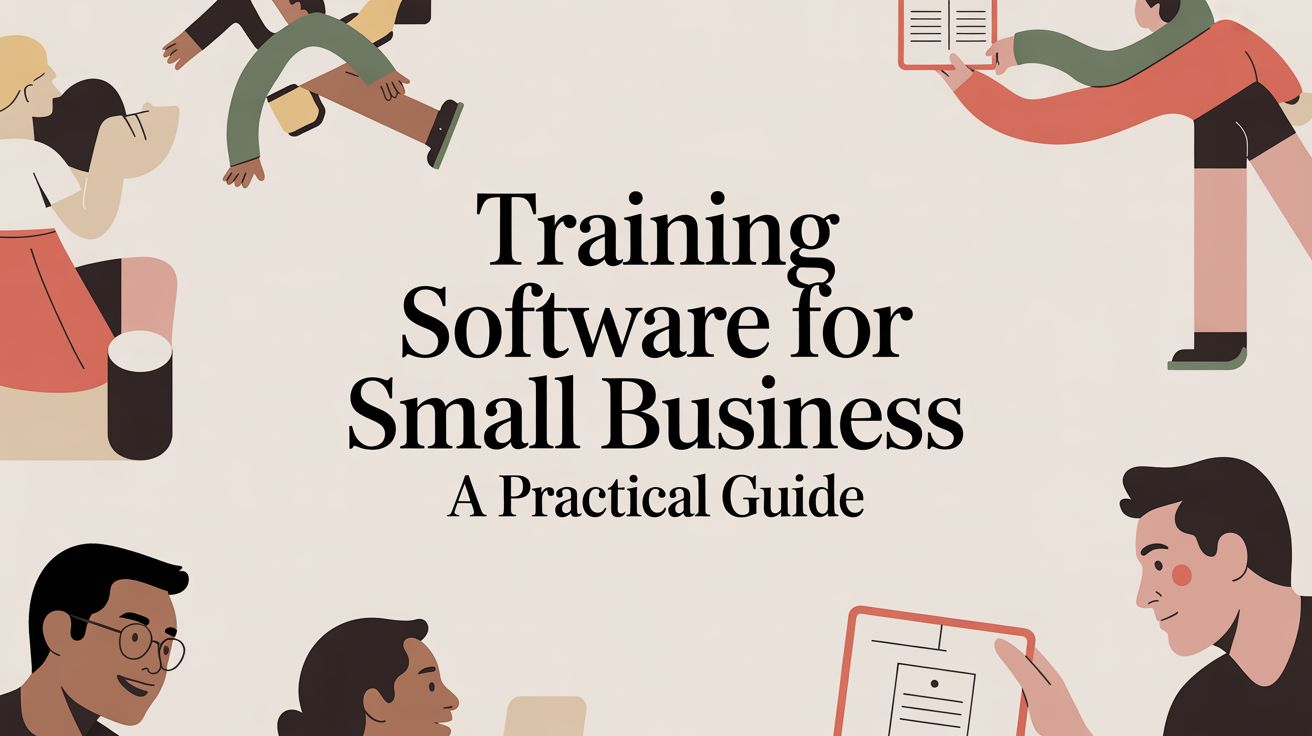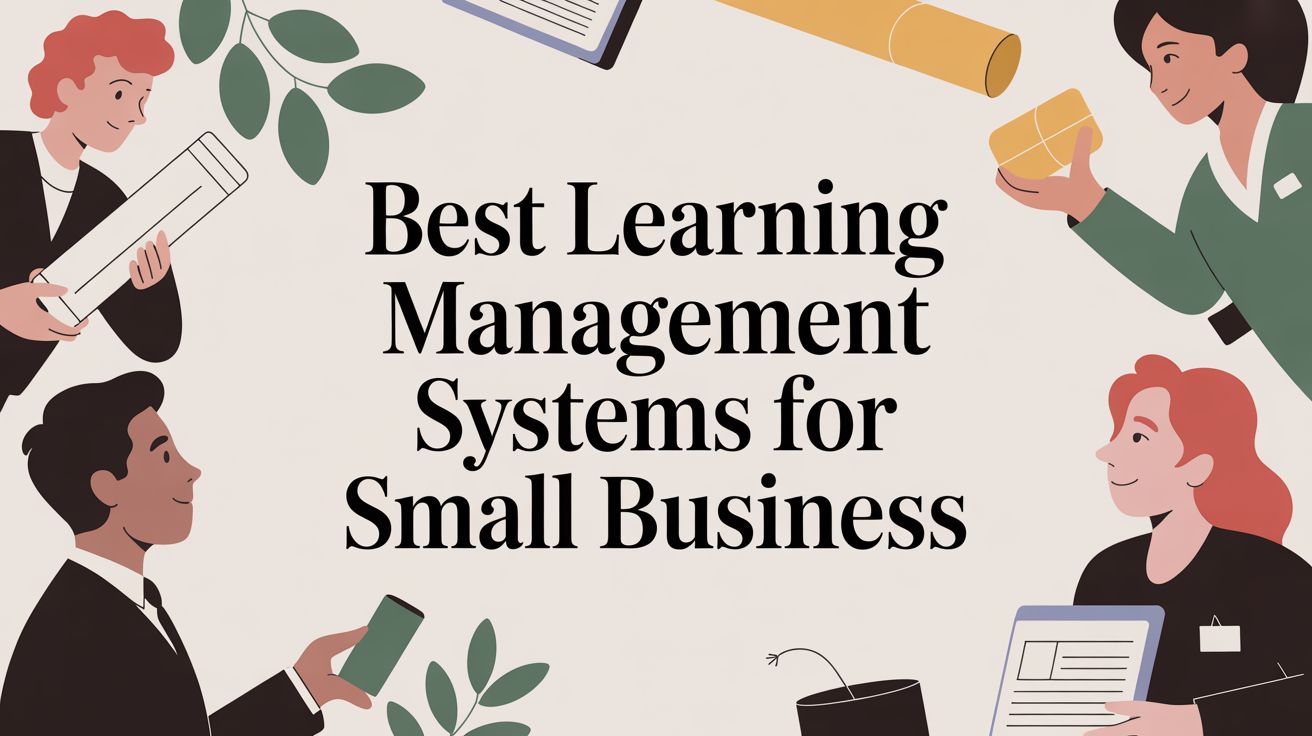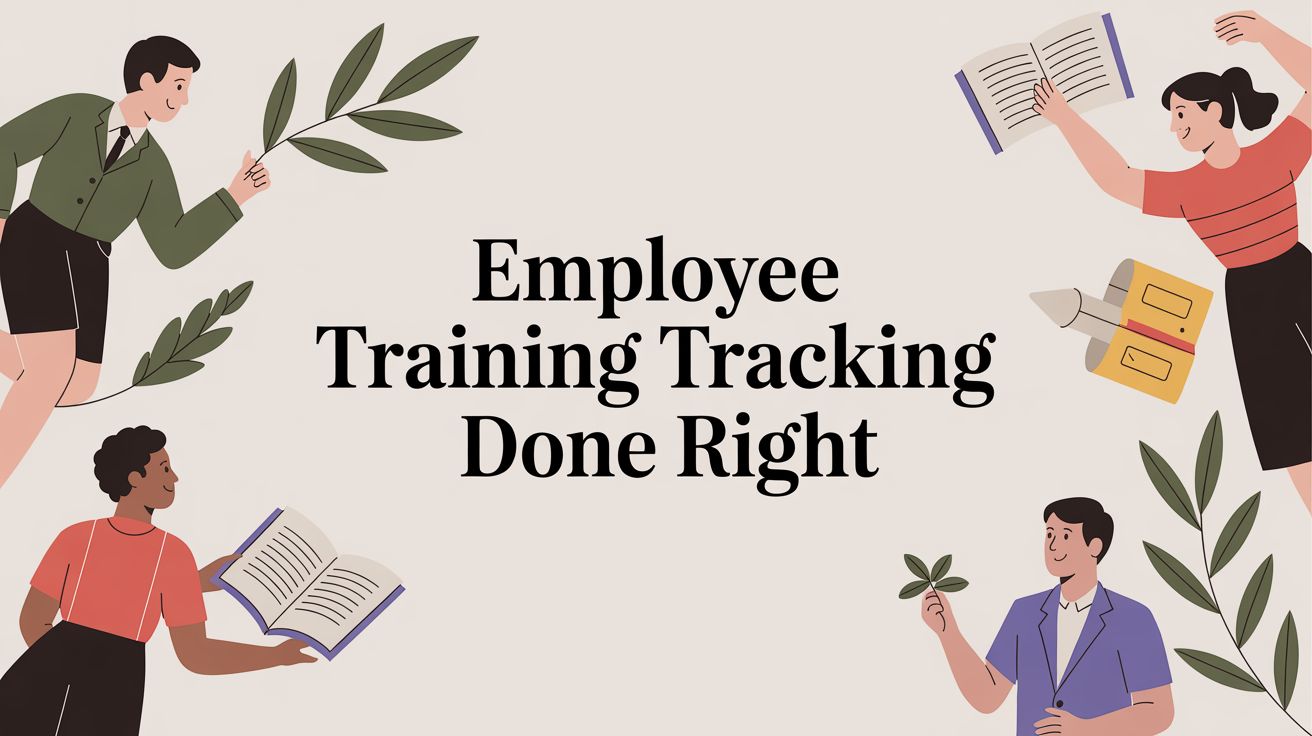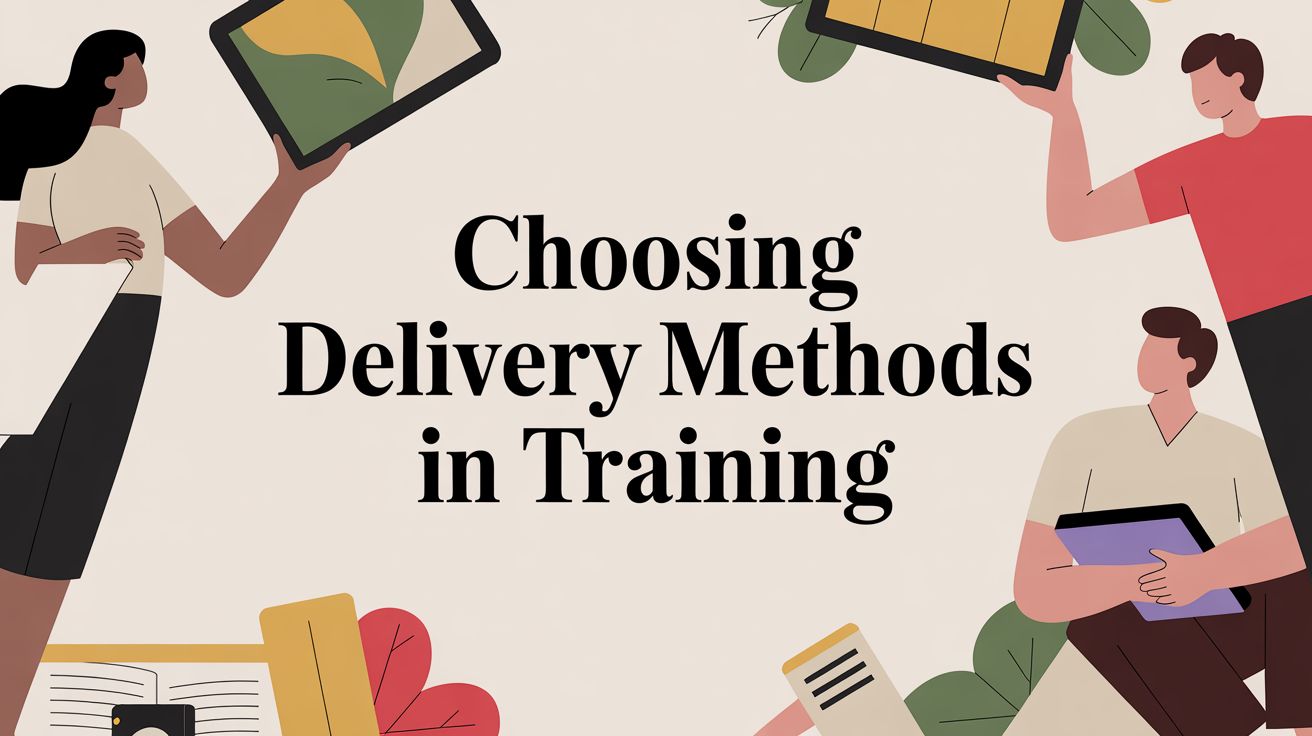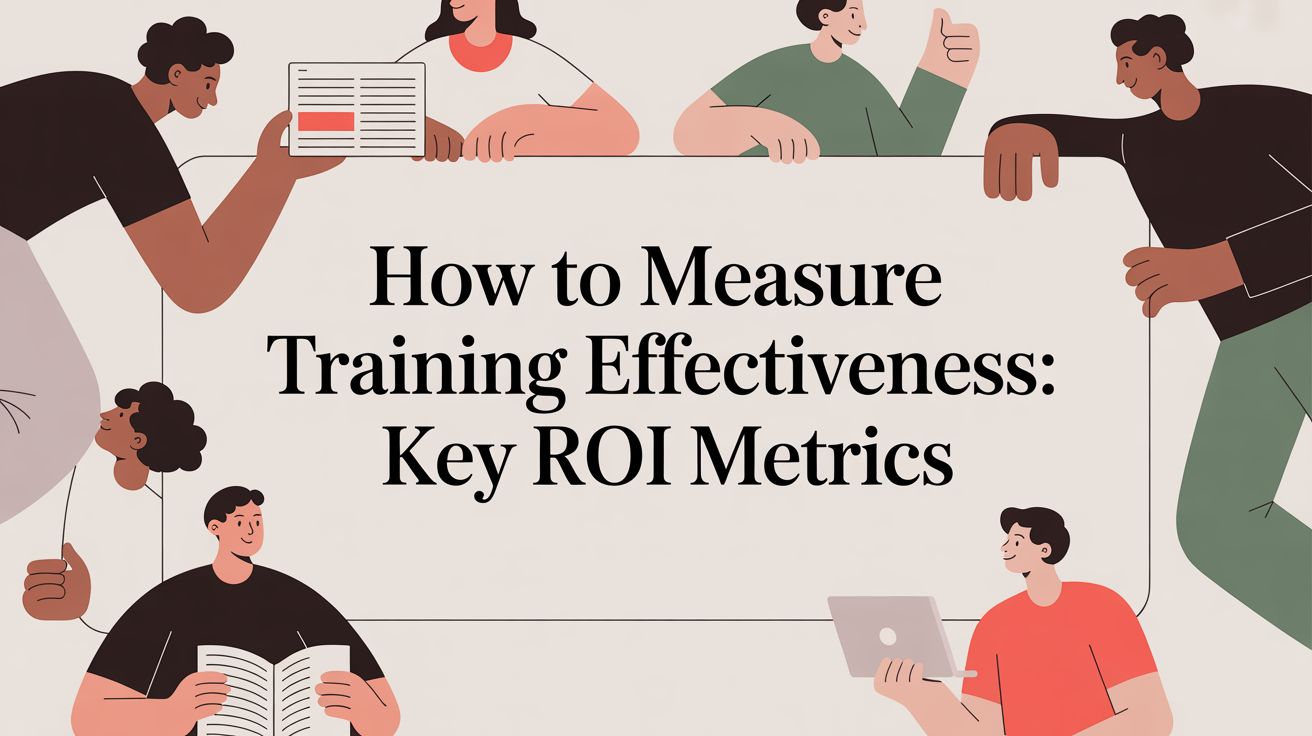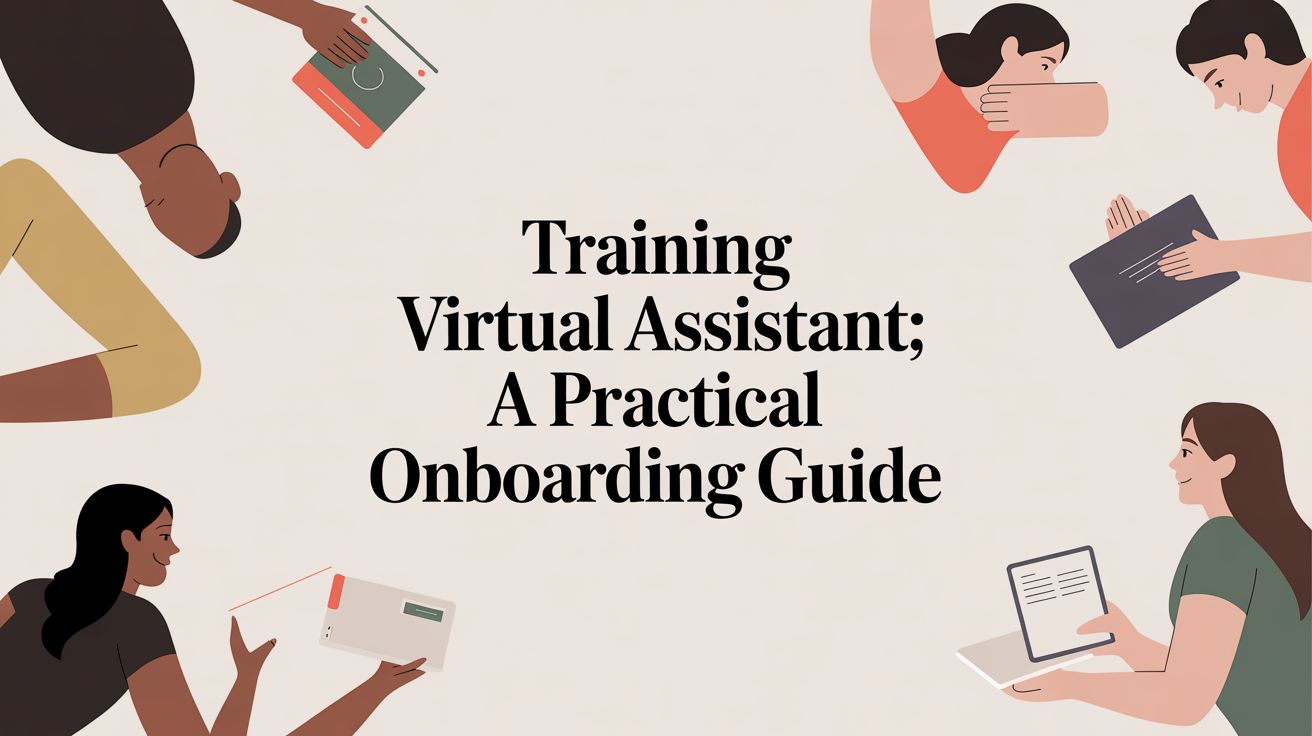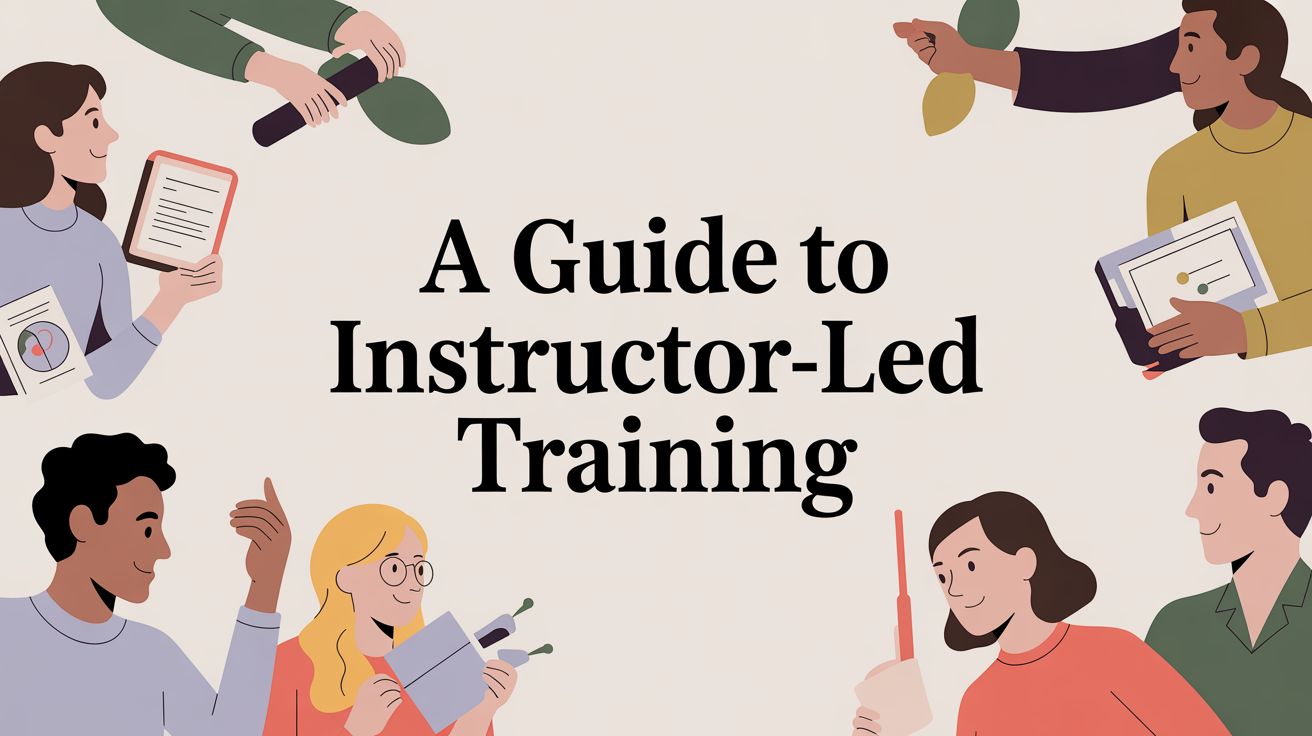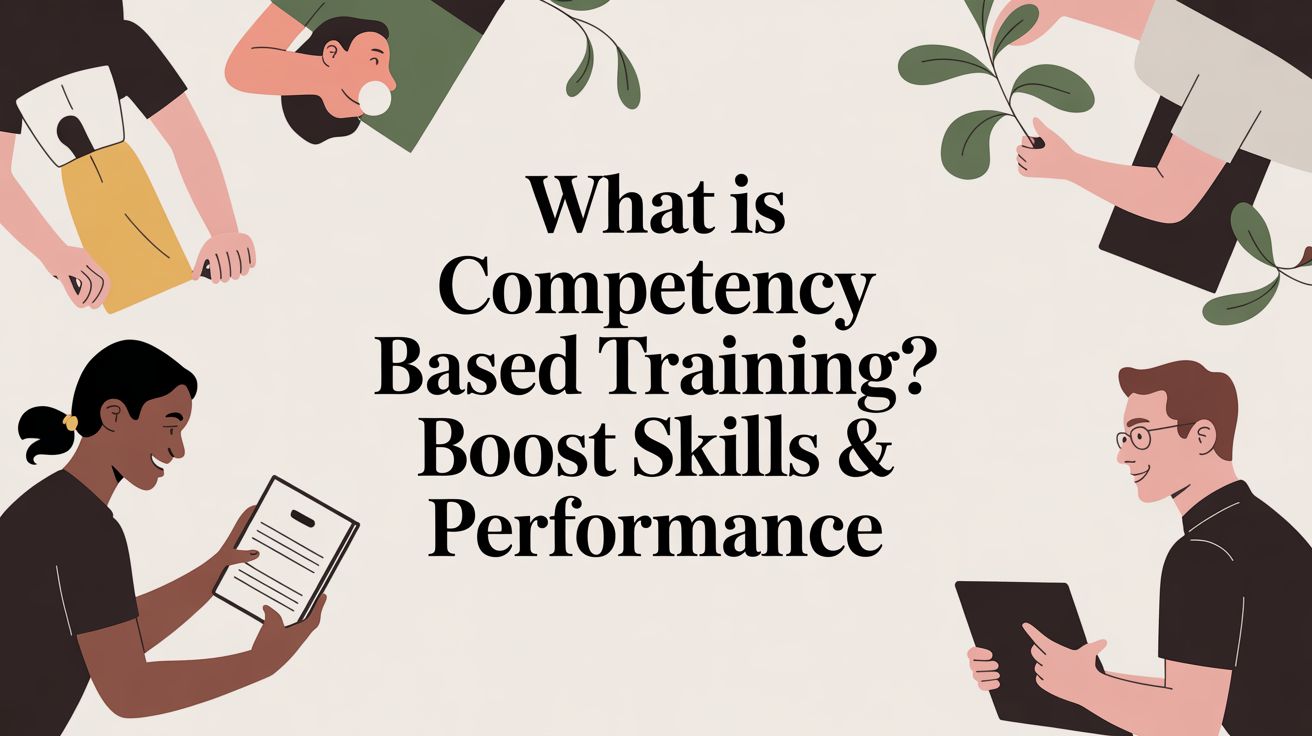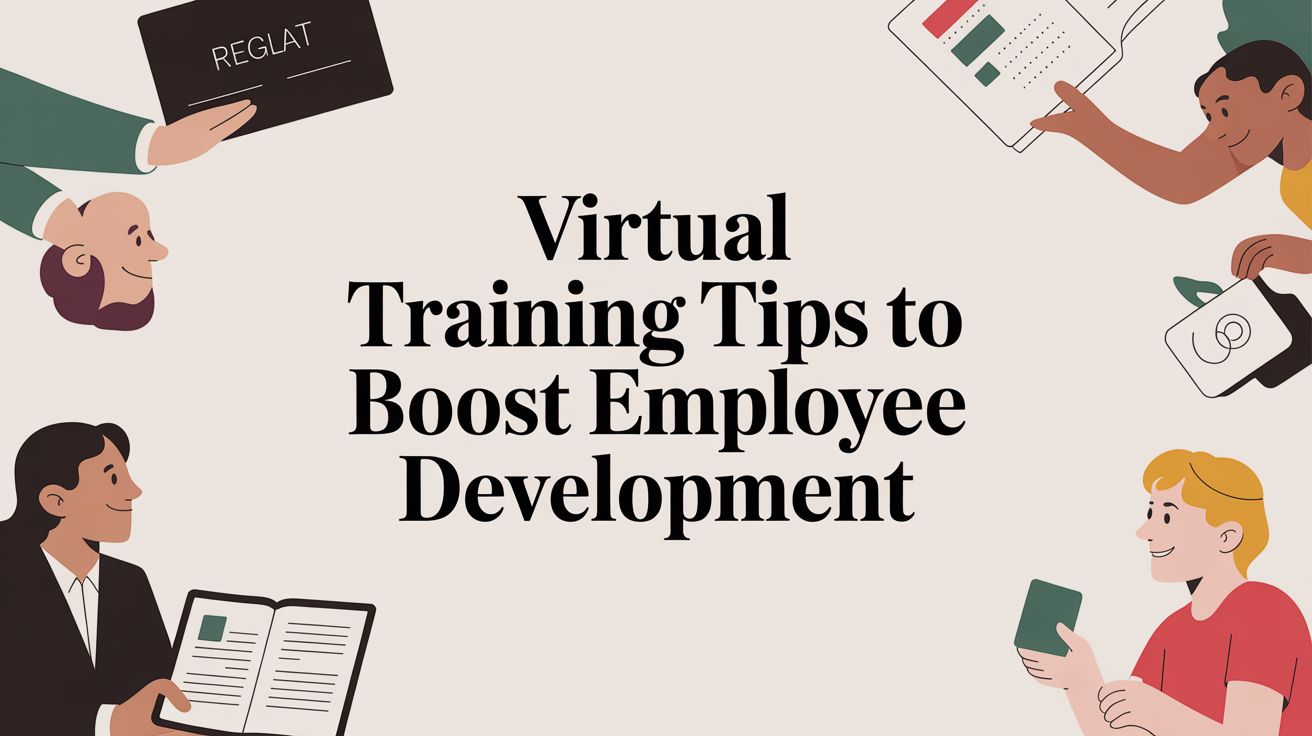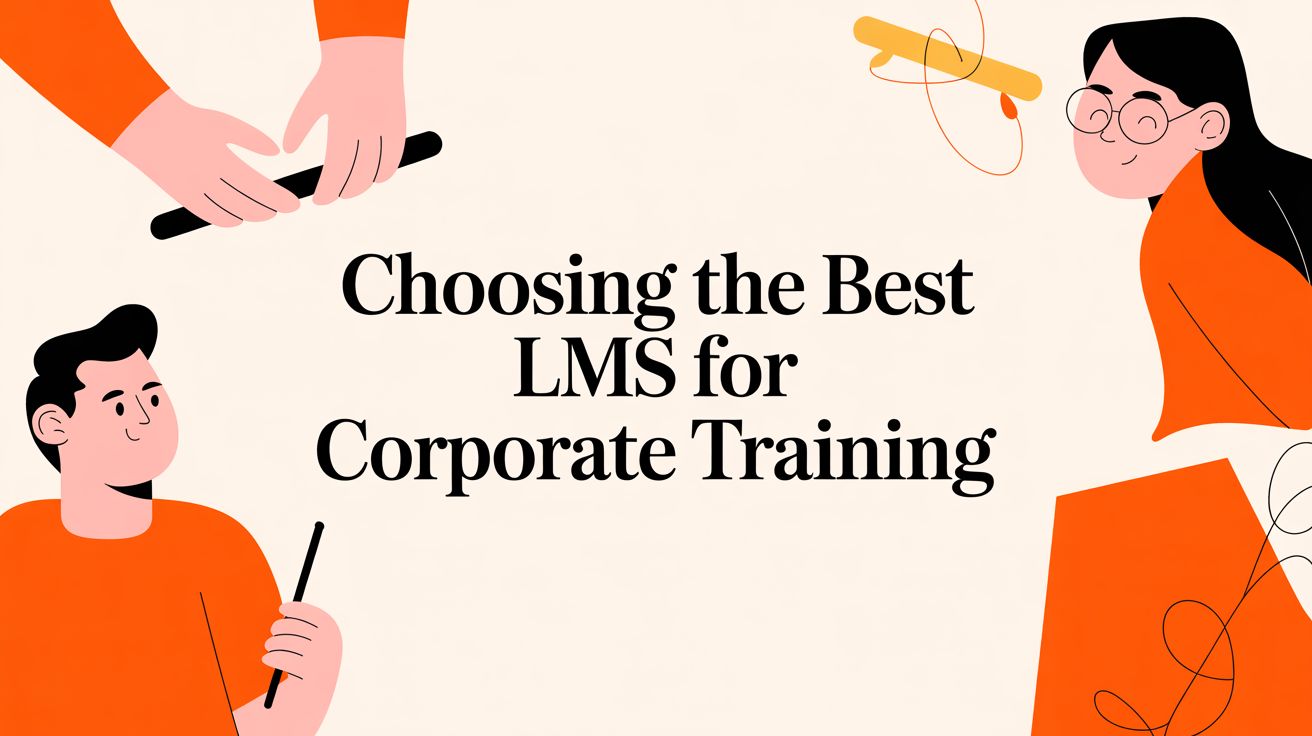Augmented Reality for Training: Boost Employee Skills
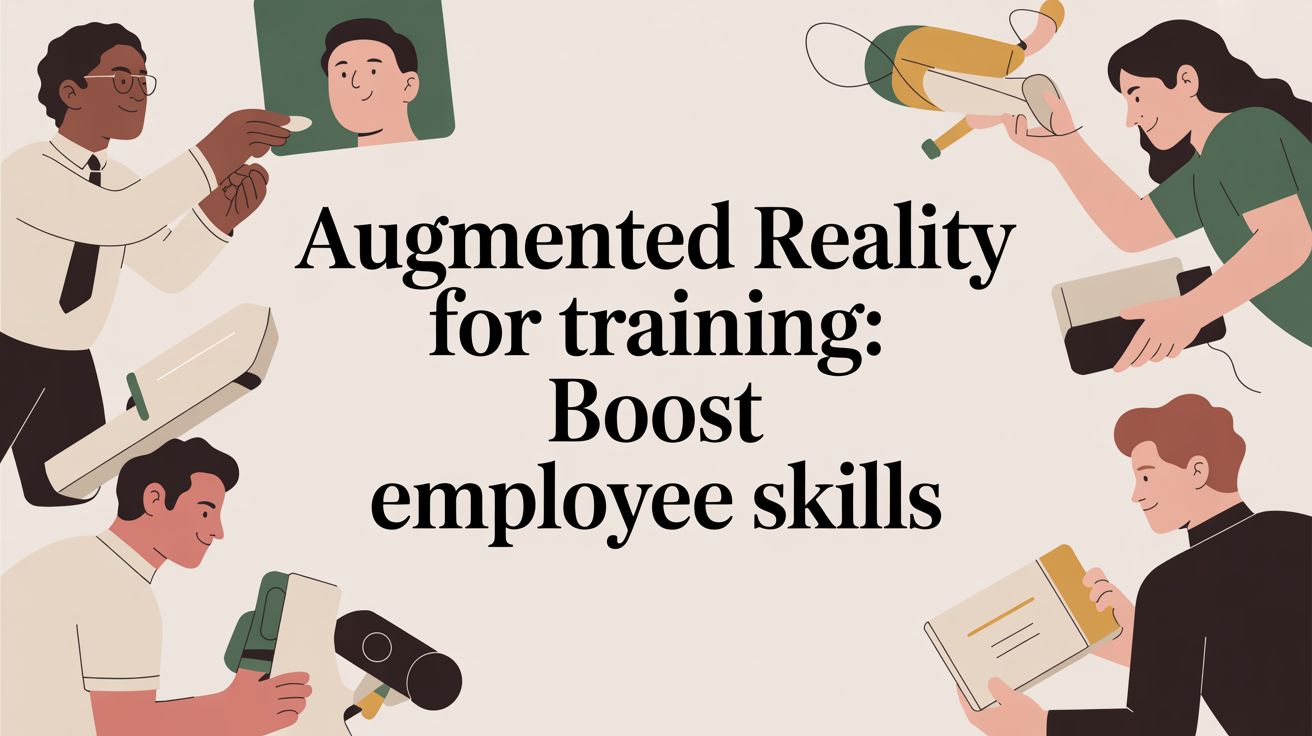
Let's be honest, nobody gets excited about staring at a thick training manual or clicking through another PowerPoint. These old-school methods just don't cut it when it comes to preparing people for real, hands-on work. They create a gap between knowing what to do and knowing how to do it, which often leads to mistakes and a painfully slow learning curve.
This is where augmented reality for training changes the game. It overlays interactive, digital instructions right onto the physical equipment an employee is working with. It turns passive learning into active doing.
Moving Beyond the Limits of Traditional Training
We’ve all been there. Classroom lectures, static manuals, even well-made videos. While methods like creating traditional training videos are a step up, they still depend on an employee's ability to memorize a bunch of steps and then recall them perfectly on the job. That’s a big ask, and it’s where errors and slowdowns happen.
Augmented reality completely flips that script. Instead of forcing employees to memorize, AR delivers step-by-step guidance right when and where they need it. It’s a true "learn-by-doing" experience, which is far more natural and effective for any hands-on task.
Think of it like a digital expert standing over your shoulder, pointing out exactly what to do next.
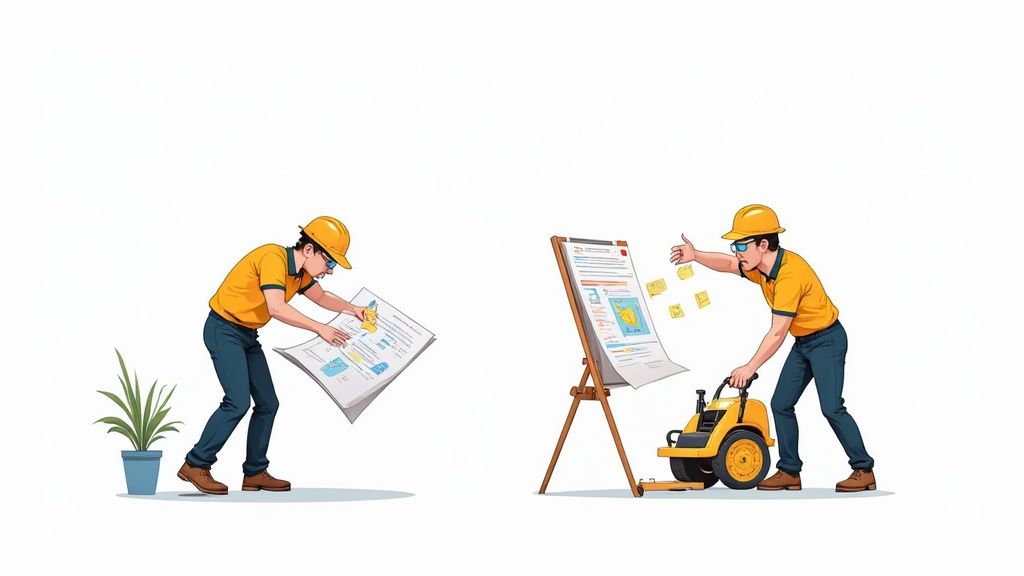
This visual overlay makes even the most complicated procedures feel intuitive. It cuts down on the mental heavy lifting, so trainees can focus all their energy on getting the task right.
The Rise of Immersive Learning
This move toward more dynamic training isn't just a fleeting trend—it's a massive shift backed by some staggering numbers. The market for augmented reality in training is set to jump from $31.26 billion in 2024 to an estimated $51.34 billion in 2025. That's an eye-popping compound annual growth rate (CAGR) of 64.3%.
This explosive growth is fueled by the simple fact that almost everyone has a powerful mobile device in their pocket. With early adopters in technical fields paving the way, forecasts show the market soaring to nearly $249.42 billion by 2029.
This isn't just about cool tech; it’s about tangible business results:
- Enhanced Safety: Trainees can get comfortable with complex machinery in a controlled, digitally guided setting, minimizing risks.
- Improved Retention: People remember what they do far better than what they just see or hear. Hands-on learning creates stronger, more lasting knowledge.
- Greater Efficiency: AR dramatically shortens the time it takes for a new hire to become a confident, productive member of the team.
Adopting AR means building a smarter, safer, and more capable workforce. These kinds of tools are the backbone of any modern, interactive training program.
How AR Training Works in the Real World
So, what does AR training actually look like on the ground? It’s all about closing that tricky gap between knowing what to do and knowing how to do it.
Picture a new technician standing in front of a complex piece of machinery. In the old days, they'd be flipping through a thick, greasy manual, trying to match diagrams to the real thing. With AR, they just point a tablet or put on a pair of smart glasses.
Suddenly, their view of the machine comes alive. Digital arrows point to the exact bolts to loosen, in the right order. A 3D model of a part pops up, showing them precisely how it fits into place. Safety warnings flash over dangerous components. It turns a daunting task into a step-by-step, guided process, cutting down on mistakes and getting them up to speed much faster.
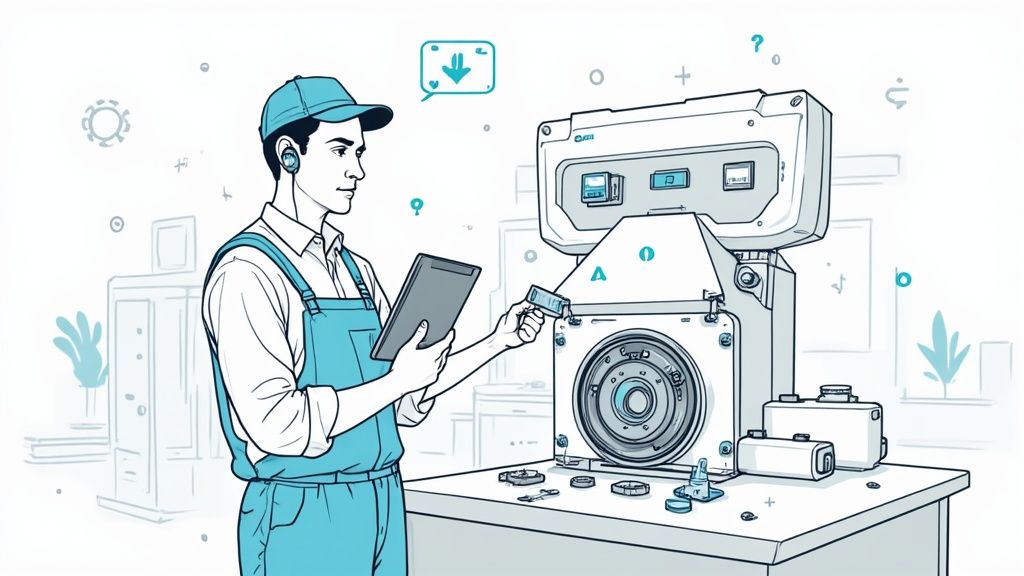
The Core Components of an AR System
This magic isn't really magic at all. It's the result of three key pieces working together seamlessly. Each one has a critical job to do.
- Hardware: This is the physical device the employee uses. It could be a standard smartphone or tablet—a great, accessible option for many companies. For more intensive, hands-on work where you need both hands free, you'd turn to dedicated AR headsets or smart glasses.
- Software: This is the brains of the operation, the app running on the hardware. The software has to recognize real-world objects, track the user's perspective, and overlay the right digital information exactly where it needs to be.
- Content: This is the instruction itself—the 3D models, animations, text guides, and videos that the employee interacts with. The success of the entire training hinges on how clear and helpful this content is. Creating this content, especially realistic 3D assets, is a crucial skill. For teams looking to scale, Mastering Text to 3D Model Conversion is becoming a vital part of the process.
Coordinating High-Tech Training Sessions
While the technology is incredible, just handing out headsets isn't enough. Running AR-based training, especially in a live or hybrid setting, brings its own logistical hurdles. You have to manage who gets which device, schedule time for hands-on practice, and keep track of everyone's progress.
Tip: An effective training program needs more than just great technology; it needs a solid organizational backbone. Without a system to manage the who, what, and when, even the most advanced tools can lead to logistical chaos.
This is where a Training Management System (TMS) comes in. A TMS is different from a Learning Management System (LMS), which is typically built for self-paced, asynchronous online courses. A system like Coursebricks is a TMS designed specifically for managing the logistical details of instructor-led, live, and hybrid training.
It helps you automate session scheduling, track device assignments for trainees, and manage instructor timetables. As you explore different delivery methods in training, you'll see how essential this kind of robust management is for blended learning. A TMS provides the framework to make sure these high-tech, hands-on training experiences run without a hitch.
The True Benefits of Immersive AR Learning
Bringing augmented reality into your training program is more than just a neat tech trick. It fundamentally changes how people learn, practice, and ultimately perform their jobs, leading to some serious improvements on the ground. The advantages are clear, measurable, and go way beyond the initial "wow" factor.
One of the biggest and most immediate wins is a massive boost in workplace safety. AR lets you create a practice environment with absolutely zero real-world risk, allowing employees to get hands-on with dangerous tasks without any of the danger.
Drastically Improved Safety
Think about an airline mechanic learning the ins and outs of a new jet engine. In the old days, they’d be working on a piece of equipment worth millions, where one wrong move could be catastrophic. With an AR overlay, they can see a digital twin of that engine, interact with every component, and run through complex repair sequences in a completely safe, controlled space.
This is a game-changer for high-stakes industries like manufacturing, energy, and healthcare. It allows people to build real confidence and competence before they ever touch live equipment, which makes a huge difference in cutting down accidents and injuries.
Superior Knowledge Retention
So, why does AR stick in our brains so much better than a thick training manual? It's all about how we’re wired to learn. When we just read or listen, it's passive, and the neural connections our brain makes are weaker. But when we actually do something, it creates strong, lasting memories.
AR is the ultimate tool for learning by doing. By physically walking through the steps of a task with digital guidance, trainees are using their motor skills and spatial awareness. This hands-on process cements the knowledge in a way that just watching a video never could. What they learn stays with them.
A study on immersive tech found that employees trained with VR—AR's close cousin—finished their training about four times faster than their classroom counterparts. What’s more, their confidence to actually use their new skills shot up by 275%, which just goes to show how powerful simulated practice really is. Discover more about these AR and VR training statistics.
Accelerated Skill Acquisition and Reduced Errors
When people can learn by doing, they naturally get up to speed much faster. With AR, the journey from novice to proficient gets a whole lot shorter. Trainees receive instant, on-the-spot feedback, letting them correct mistakes as they happen and master procedures in record time.
This faster learning curve directly impacts how well your business runs.
- Fewer Costly Mistakes: When employees get real-time, step-by-step instructions overlaid on their work, the chance of making a mistake plummets. This is critical for complex assembly or maintenance jobs where one slip-up can mean expensive rework or damaged equipment.
- Increased Employee Engagement: Let's be honest, traditional training can be a drag. AR turns it into an engaging, almost game-like experience. That interactivity grabs people's attention and keeps them motivated, making them more invested in actually learning.
- Better Performance Metrics: All of these benefits—safer work, better retention, and faster learning—add up to real, measurable results. Proving the value of your AR program is crucial, and knowing how to measure training effectiveness is the key to showing that powerful ROI.
AR Training in Action: Real-World Success Stories
The impact of augmented reality in training isn't just a concept on a whiteboard; it's delivering real, measurable results for major companies today. The market for this kind of immersive training is booming for a reason. It was valued at around USD 16.4 billion in 2024 and is on track to hit nearly USD 69.6 billion by 2030, according to industry analysis. You can dig deeper into the immersive training market growth to see the numbers behind the momentum.
But numbers only tell half the story. The real proof is in how AR is solving day-to-day business problems across wildly different industries.
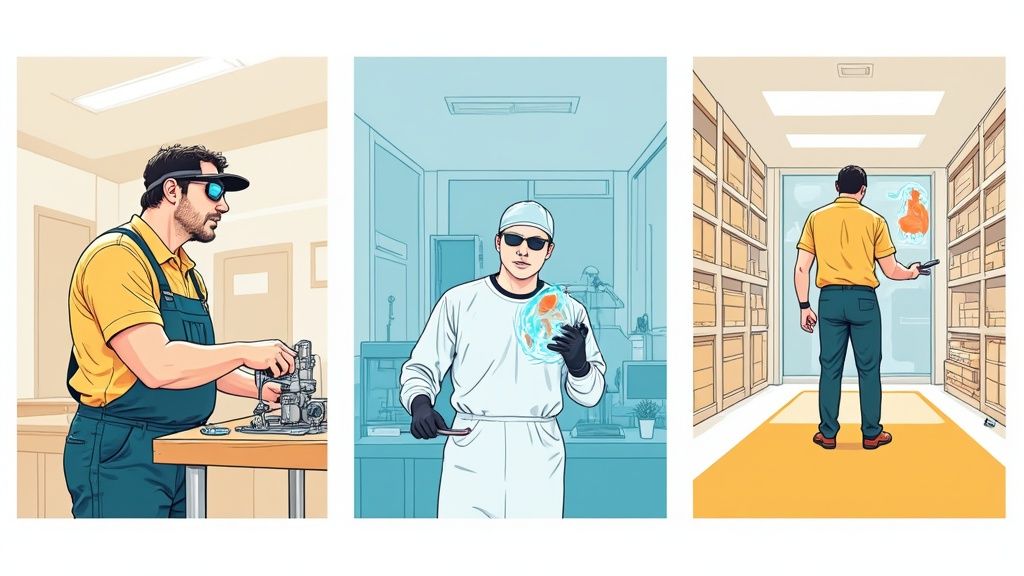
Manufacturing Precision and Efficiency
In a busy manufacturing plant, a small assembly mistake can snowball into huge costs and production delays. One large industrial equipment maker turned to AR glasses to guide its technicians through complex assembly jobs. Workers no longer have to stop, put down their tools, and flip through a paper manual. Now, they see digital instructions and 3D diagrams overlaid right on their workstation.
The change was immediate and dramatic. In the first year alone, they saw an 82% drop in production errors. This kind of real-time, hands-on guidance not only boosted quality but also helped new employees get up to speed far more quickly.
Healthcare and Surgical Accuracy
The operating room is a place where there is zero margin for error. Forward-thinking healthcare systems are now using AR to give surgeons something like a superpower: X-ray vision. Before a complex procedure, they can take a patient's CT or MRI scans and create a 3D model of their organs. During the surgery, this model is projected directly onto the patient's body.
This gives the entire surgical team an unprecedented view of the internal anatomy, helping them navigate with more confidence and avoid damaging critical nerves or blood vessels. It’s a game-changer for training new surgeons and an incredible co-pilot for even the most seasoned veterans.
Key Takeaway: AR’s true power is its ability to blend digital information with our physical reality. It bridges the gap between knowing what to do and actually doing it, right when it matters most.
Logistics and Warehouse Operations
Warehouses are all about speed and accuracy, but they often struggle with high employee turnover. To solve this, a major logistics company gave its new warehouse pickers AR smart glasses. The glasses show them the fastest route to an item, highlight the correct box on the shelf, and even confirm the pick with a built-in scanner.
With this intuitive visual guidance, new hires were hitting their full productivity targets in half the usual time. Because the system is completely hands-free, workers could focus on the task without fumbling with a scanner or clipboard, which also made the whole operation safer.
Comparing AR Training with Traditional Methods
When you place AR-based learning side-by-side with conventional methods, the advantages become crystal clear. The following table breaks down how AR stacks up against classroom or on-the-job training across key areas.
| Metric | Traditional Training | Augmented Reality Training |
|---|---|---|
| Error Rate | Relies on memory, leading to higher error potential | Real-time guidance drastically reduces mistakes |
| Time to Proficiency | Weeks or months of shadowing and practice | Accelerated learning curve, often in half the time |
| Information Access | Requires stopping work to consult manuals or screens | Hands-free, instant access to data in the line of sight |
| Safety | Requires memorizing safety protocols | Proactive, contextual safety alerts appear in real-time |
Ultimately, AR isn't just a fancier way to present information. It’s a fundamentally different approach that integrates learning directly into the workflow, leading to safer, faster, and more accurate performance.
Your Blueprint for Launching an AR Training Program
Alright, let's move from theory to reality. Getting an augmented reality for training program off the ground might seem like a huge undertaking, but it’s entirely manageable if you approach it correctly. The trick is to break it down into a few logical steps.
You don't need to reinvent your entire training department overnight. Start small, focus on a single clear goal, and build from there.
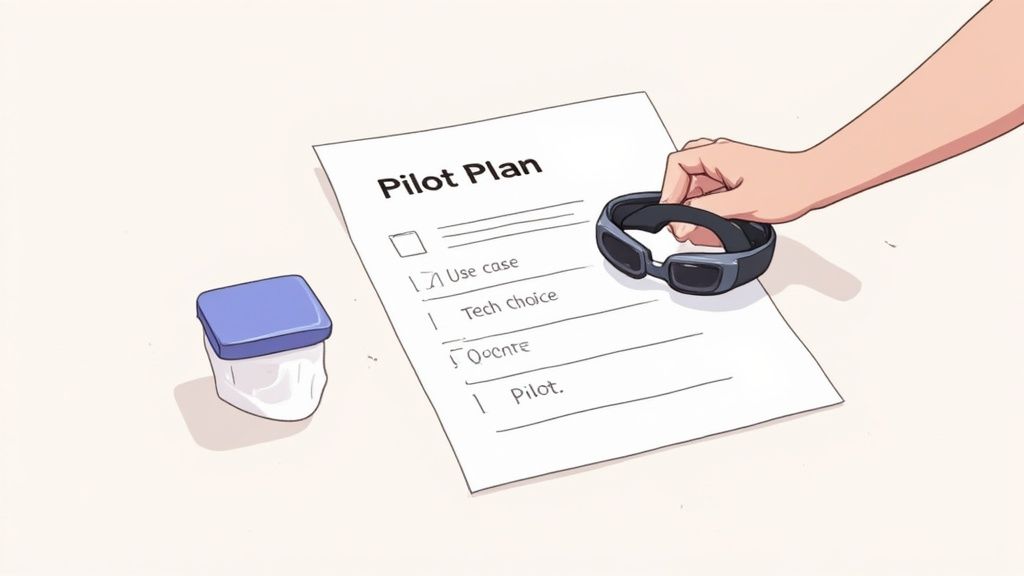
Pinpoint the Perfect Use Case
First things first, you need to find the one area where AR will make the biggest impact right away. Think about your most complex, high-stakes tasks or those with a brutal learning curve.
Where do mistakes cost you the most time and money? Those are your prime candidates. Zero-risk practice in a digitally guided environment is a game-changer for these scenarios.
Ask yourself a few direct questions to narrow it down:
- What training process is our biggest bottleneck?
- Which on-the-job errors are the most common or costly?
- Where are my technicians constantly stopping to check a manual?
By targeting a high-impact problem first, you'll have a much easier time proving the program's value to decision-makers.
Select the Right Technology
With a use case in mind, it's time to think about hardware. You don't always need the most expensive, top-of-the-line gear. The right choice depends entirely on the job at hand.
- Mobile-First Approach: For a lot of situations, the smartphones and tablets your team already has are more than enough. This is a fantastic, low-cost way to get started, especially for tasks where an employee has a free hand.
- Dedicated Headsets: Now, if you're training someone on a complex repair or assembly line where they need both hands, AR smart glasses or headsets are the way to go. They offer a true hands-free, integrated experience.
Create Your Training Content
Next up: the actual training content. You've got two main options here—either buy ready-made modules or build your own from scratch.
Pro Tip: When you're building the business case, talk in terms of efficiency. What does one major production error cost the company? How many weeks does it take a new hire to become fully productive? When you frame AR as the direct solution to these expensive problems, the investment starts to make a lot of sense.
Off-the-shelf content is quick and works well for standard industry procedures. But for your company’s unique equipment and processes, a custom-built experience will almost always deliver better results in the long run.
Execute a Pilot Program and Manage Logistics
Don't go all-in at once. Start with a small pilot program and a control group. This is your chance to collect real data, prove the concept works, and smooth out any wrinkles in the process before a full-scale deployment.
Let's be clear: managing hybrid or in-person sessions with this kind of tech requires serious coordination. This is where a dedicated training management system (TMS) like Coursebricks becomes invaluable.
A standard Learning Management System (LMS) isn't built to handle the nitty-gritty of scheduling live sessions, tracking AR devices, and assigning instructors. A TMS is designed for that operational heavy lifting. While researching the best LMS for corporate training is useful for understanding the software landscape, you need a TMS for the specific logistical demands of instructor-led AR training.
Prove it works on a small scale, and you’ll have a rock-solid case for expanding the program across the entire organization.
Common Questions About AR in Corporate Training
Anytime a powerful new tool comes along, a lot of practical questions follow. It's only natural. Before committing to augmented reality, business leaders want to know about the real-world differences, the costs, and what it takes to actually get it up and running.
This section is all about tackling those common queries. Let's clear up the confusion so you can move forward with confidence.
What's the Real Difference Between AR and VR for Training?
This is easily the most common question I get, and the answer comes down to one simple thing: how each technology interacts with the world around you.
Augmented Reality (AR) is all about adding a digital layer on top of your physical environment. It enhances reality, it doesn't replace it. Picture a mechanic seeing digital instructions pop up over a real engine, or a new warehouse picker seeing glowing arrows guiding them to the right shelf. AR is perfect for on-the-job training where you need to interact with real objects.
Virtual Reality (VR), on the other hand, pulls you into a completely digital world. The moment you put on a VR headset, you’re somewhere else entirely. This is fantastic for creating simulations that would be too dangerous, expensive, or just plain impossible to replicate in real life—like training for a hazardous chemical spill or practicing a complex surgery without any risk.
Is AR Training Just for Big Companies With Deep Pockets?
There's a persistent myth that AR is too expensive for a smaller business, mostly because the early hardware was incredibly pricey. Thankfully, that's not the world we live in anymore. The game-changer is that many of the best AR training apps run on the very same smartphones and tablets your team already has in their pockets.
The trick is to start smart, not big.
- Pinpoint one high-impact task where AR could make an immediate difference.
- Run a small, focused pilot program to prove its value and measure the return.
- Use the data from that successful pilot to make the case for expanding the program.
Plus, a growing number of companies now offer ready-made AR training platforms, giving you a way to get started without a huge upfront investment in custom development.
How Do You Actually Run an Instructor-Led AR Session?
Juggling a room full of trainees, each with their own AR device, adds a new layer of complexity to instructor-led training. This is where a dedicated training management system (TMS), like Coursebricks, becomes absolutely essential. A standard LMS is great for asynchronous, online courses, but a TMS is built specifically for the logistical chaos of live, face-to-face, or hybrid training events.
Tip: Think of a TMS as the organizational backbone for your high-tech training. It helps you schedule sessions, track who has which pair of AR glasses, monitor attendance and performance, and take a huge administrative load off your instructors. It's what makes the whole operation run smoothly.
What's Next for AR in Workforce Development?
The future of augmented reality for training is incredibly exciting, and it’s all about smarter integration. We're moving away from simple digital overlays and toward systems that are truly intelligent and responsive.
Get ready to see much tighter connections between AR, Artificial Intelligence (AI), and the Internet of Things (IoT). Imagine AI personalizing training content on the fly based on an employee's performance, or IoT sensors feeding real-time data from a machine directly into an AR simulation. As the hardware gets lighter, cheaper, and more powerful, hands-free intelligent guidance is set to become the new standard for nearly every hands-on job out there.
Ready to explore Coursebricks?
Manage training programs, automate emails, and generate detailed reports — all in one place.






